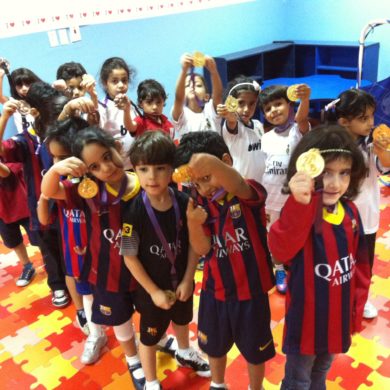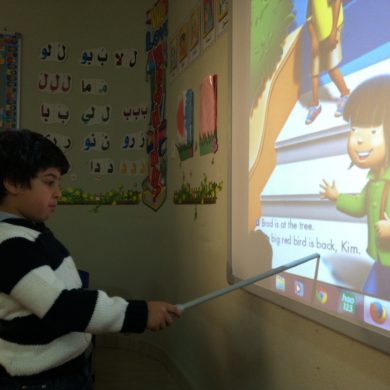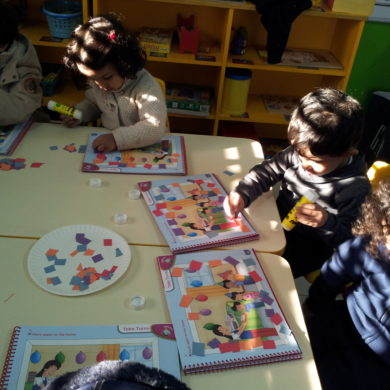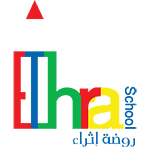KG Program
Curriculum
Laying the right foundation for your child’s academic success starts with kindergarten.
Ethra school follows the National Kindergarten Program for the Ministry of Education in the Kingdom of Saudi Arabia and the American Common Core Standard curriculum which includes English Language Arts, Mathematics and other skills.
Students get the opportunity to grow and develop through play by offering a wide range of learning experiences and activities that are both stimulating and fun.
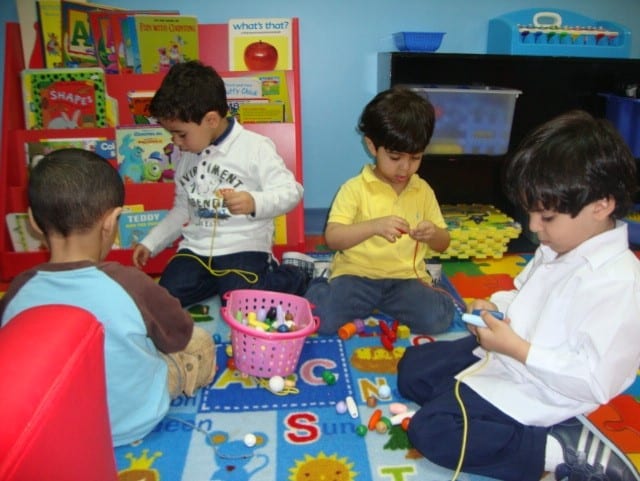
Our program
- Supports all developmental domains, social, emotional, cognitive and physical.
- Provides a combination of formal and informal activities that encourage children to be self-directed learners.
- Builds children’s background knowledge and thinking skills.
- Builds a strong foundation in language development, early literacy and early math by developing the skills that they need for reading, writing and mathematics.
- Offers a balance of play and structured activities appropriate to each age level.
Students are also evaluated through several techniques, including daily observation, performance tasks continuous and cumulative assessments, and academic progress level tests at the end of each semester.
Arabic Program - برنامج العربي

يعتمد منهج رياض أطفال على أسلوب التعلم الذاتي الذي يركز على النشاط الذاتي للأطفال أنفسهم بحيث يتفاعل كل طفل ويتعامل مع الألعاب التربوية الهادفة المتوافرة في بيئته التربوية والتي تساعده على اكتشاف قدراته وتنميتها بما يتناسب مع نمط النمو الخاص به, لذا يعد منهج رياض أطفال منهج التعلم الذاتي ويأخذ بعين الاعتبار عوامل الواقع الميداني.
فالتعلم الذاتي يعني أن يتعلم الطفل من ذاته وأن ما يحركه حاجاته الذاتية للتعلم. كما أنه اعتمد على الأسلوب الإسلامي في التعامل وذلك بالتركيز على أسلوب القدوة في التعامل واستعمال أساليب التوجيه والمديح الفعال والإقناع.
ويركز منهج التعلم الذاتي على تنمية القيم الإسلامية: مبادئ الصدق والصراحة وحرية إبداء الرأي والاعتزاز بالذات والاعتماد عالنفس.
يتضمن المنهج مجموعة من الوحدات للمنهج التطبيقي, و يشمل عشر وحدات تعلمية تصف النشاطات التطبيقية التي تقوم بها المعلمة مع الأطفال وهذه الوحدات التعليمية قسمت الى جزأين: ست وحدات تعلمية مفصلة وخمس وحدات موجزة.
المبادئ التي يقوم عليها برنامج رياض أطفال:
- أهمية الخبرات الحسية Sensory experiences في إكساب الأطفال الخبرات المختلفة.
- الاهتمام برغبات وحاجات الأطفال.
- منح الطفل الحرية في إطار محدد.
- تعليم الطفل عن طريق اللعب والعمل.
- يميل الأطفال إلى اللعب بالأدوات المتعددة الاستخدام( يكررون استخدامها عدة مرات).
- الاهتمام بالخبرات المباشرة ( الأشياء الحقيقية) ”Real Thing“.
- التركيز على مفاهيم الحياة اليومية والسلوكيات المناسبة.
- الاهتمام بالبيئة المعدة إعداداً جيداً.
- تنمية الاستقلالية والاعتماد على النفس عند الطفل.
- التعلم الذاتي من خلال الوسائل والأدوات Auto Education.
طرق إتقان المهارات والممارسات :
- يتعلم الطفل بالتدرب المستمر على المهارات حتى يصل الى درجة عالية من الإتقان .
- يتعلم الطفل بالاكتشاف والبحث والتقصي.
- يتعلم الطفل من خلال عمليات النضج والتطور فينتقل من مرحلة الى أخرى.
- يتعلم الطفل خلال تلقيه معلومات جديدة من مصادر متنوعة بالإضافة الى تجاربه الذاتية وتدربه على بعضها.
برنامج متوازن:
- يحقق التوازن بين النشاطات الحرة والنشاطات المنظمة.
- يحقق التوازن بين النشاطات الفردية والنشاطات الجماعية.
- يحقق التوازن بين النشاطات الفكرية العقلية والنشاطات الترفيهية والحركية.
برنامج القراءة والكتابة لمرحلة الروضة:
تعتمد مدرسة إثراء منهج ((هيا نقرأ)) لمرحلة التمهيدي وسلسلة الأوائل التعليمية لمرحلة روضة ثاني في ما يخص المهارات اللغوية. وذلك من اجل إتقان اللغة و اكتساب مهارات عديدة للقراءة والكتابة ومن هذه المهارات الإنصات, والتمييز السمعي, ودقة الملاحظة, والتمييز المرئي وكذلك تناظر العين مع اليد, ونمو الأنامل الصغيرة, والقدرة على التركيز, والميل نحو التواصل, والتعبير بواسطة اللغة الشفهية والكتابية, والاستعداد للقراءة والكتابة، حيث يتعلم الطفل مهارات عديدة تقوي نموه اللغوي الكامل على النحو الآتي:
- يتعلم النطق الصحيح للكلمات
- يتعلم تكوين الجمل السليمة
- يتعلم التمييز البصري الذي هو أساس القراءة
- يتعلم التعبير اللفظي
- تزداد مفرداته
- يكتب اسمه
- يتعرف على شكل الحرف واسمه وصوته
- يكتب الحروف بالحركات والمدود
- يقرأ كلمات
- يكتب كلمات
- يقرأ جمل قصيرة
English
Ethra School is following the U.S. curriculum with Common Core Standards (CCSS), and Science with NGSS standards.
The English Language Art (ELA) and Mathematics curriculums are aligned with the US Common Core Standards (CCSS), while the Science program is aligned with the Next Generation Science Standards (NGSS). We provide teacher support so that classrooms can utilize all the features that Alpha’s programs have to offer.
We have adopted the following standards that serve as the foundation for building our curriculum and programs.
Standards
- English Language Arts (Common Core State Standards)
- Mathematics(Common Core State Standards)
- Science (Next Generation Science Standards)
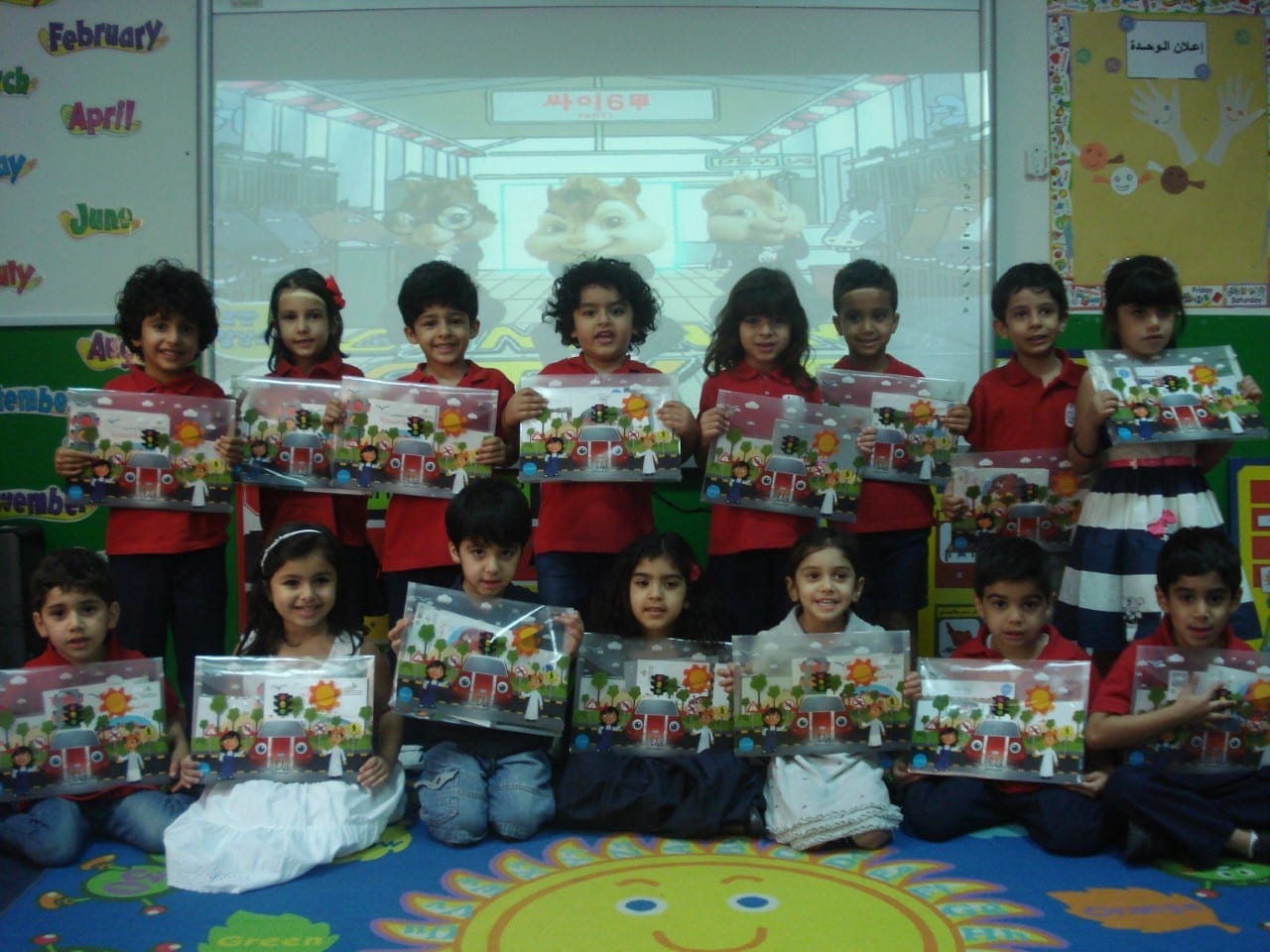
KG1 Level
Houghton Mufflin Program:
The core of the Houghton Mifflin curriculum features high-quality literature, child-centered themes and a flexible lesson structure that specifically develops critical early literacy skills, such as oral language, listening comprehension, vocabulary, phonological awareness, print awareness and alphabet knowledge. The program also teaches mathematics on a daily basis, and incorporates activities to address social/emotional development, physical development, science, social studies, music and art.
Houghton Mifflin PRE-K is a hands-on, minds-on curriculum that is based on scientific research. Aligned with key Pre-K learning goals, it provides children with the foundational skills they need to succeed as lifelong learners.
LESSONS:
Young Minds Preschool specializes in helping children establish a strong educational foundation that will enhance the probability of education success and personal confidence. With proven philosophy centered on instilling positive self-esteem, focus is on the development of the whole child:
- Socially
- Emotionally
- Cognitively
- Physically
At Young Minds Preschool, we take great pride in fostering children’s love for learning. Children who become confident have the greatest potential for success in school and in life.
The curriculum includes ten engaging and child-centered themes that will spark imaginations and a love of learning:
|
 |
At age 3, children are engaged in activities that encourage them to explore the world. The big ideas of the lessons include:
- Using My Senses
Children learn about their five senses. - Outside My Door
Children use their senses in daily experiences. - We’re Detectives!
Children investigate nature. - Weather Report
Children talk about different kinds of weather. - All Year Long
Children learn how weather affects the environment. - Seasons Change
Children discover how and why the seasons change. - I Love Animals
Children share what they like about animals. - Animals We Know
Children see and discuss familiar animals. - Animals on Land and Sea
Children learn about animals in the wild. - I Can Build
Children explore making and building things. - Build with Me
Children work together to solve a problem. - Everybody Builds
Children plan together to accomplish a big job. - Country Life
Children learn about life and animals on a farm. - The Busy, Busy City
Children find out about the bustle of city life. - To Market, To Market
Children discover how products get to market.
KG2 Level
In Pre-K, students should be immersed in a rich environment and have numerous opportunities that foster independence and autonomy in order to meet college and career readiness expectations. As familiar adults support development in Approaches to Learning, children illustrate continuous growth in their ability to function appropriately within the classroom, throughout routines, and during transitions. Children demonstrate positive growth in Approaches to Learning when they take on appropriate leadership roles within their environment. They demonstrate increased abilities in expressing needs, feelings, and positive coping skills. Children also show development in problem solving, independence, and group work.
Young children make learning connections through authentic hands-on experiences. Teachers that allow children time to explore and discover both inside and outside, optimize children’s ability to internalize and generalize content by making their own connections to prior knowledge. All children, regardless of age and ability, need opportunities to engage in learning activities and experiences that are immersed in play.
Acknowledging that each child’s development is significantly affected by previous experiences, school readiness also entails the capacity of schools and programs to welcome families and be prepared to serve all children effectively within the developmental domains of:
- Health and physical development,
- Social and emotional development,
- Language and communication,
- Cognition and general knowledge, and
- Individual approaches to learning.
1-ScottForesman Reading Street Program:
Scott Foresman Reading Street Reading Comprehension Program for Grades PreK.
Reading Street is designed to help teachers build readers through motivating and engaging literature, scientifically research-based instruction, and a wealth of reliable teaching tools. The reading program takes the guesswork out of differentiating instruction with a strong emphasis on ongoing progress-monitoring and an explicit plan to help with managing small groups of students. In addition, Reading Street prioritizes skill instruction at each grade level, so teachers can be assured they will focus on the right reading skill, at the right time, and for every student.
Program Components
Some of the basic components of Reading Street include the following:
- Student Edition
- Teacher’s Edition
- Leveled Readers
- Trade Books
- Big Books
Student and Teacher’s Edition
Two of the most important components are the Student and Teacher’s Editions. The Student Edition features quality, authentic literature organized around unit concepts. Students also practice their higher-order thinking skills and complete writing assignments that prepare them for high-stakes tests.
The Teacher’s Edition includes research-based core instruction that is systematic, explicit, and focused on priority skills. To help address the diverse needs of the students, differentiated instruction for below-level, on-level, and advanced learners is also provided.
Assessment
- A critical component that distinguishes Reading Street is the assessment. The program outlines a four-step assessment plan that helps ensure that the students make adequate yearly progress:
- Diagnose and differentiate the students’ needs as the four steps are followed.
- Monitor the students’ progress as they advance through the program with the help of resources like Monitor Progress boxes, weekly assessments, and shared reading notes.
- Assess and regroup students according to their performance levels at various milestones, such as the end of a unit.
- Perform summative assessment through Unit Benchmark and End-of-Year Assessment tests that help guide students to advanced reading levels.
Leveled Readers
The Leveled Readers allow students more opportunities to practice the same skill, strategy, and vocabulary as the main selection. Students will also benefit from another conceptually coherent reader at an appropriate level. Choose between three levels: On- Level, Strategic Intervention, and Advanced. Leveled Readers are available for English Language Learners as well, and they’re available online in SuccessNet through the Leveled Reader database.
Trade Books and Big Books
Trade books that extend students’ reading and concept development are also used in Reading Street. Each unit in the program has an On-Level, Strategic Intervention, and Advanced trade book to support all reading abilities. Similarly, Big Books that develop concepts and oral vocabulary and can be used to monitor listening comprehension skills are also used.
Phonics and Word Study
The Phonics and Word Study component provides additional resources and activities to help teach phonics. These resources include
- Sound Spelling Cards that can be used to introduce each sound spelling in the phonics lessons. Each card includes an instructional routine with a spelling generalization, a photograph to represent the target sound, and a list of spellings for the sound.
- Alphabet Cards that can be used to help students develop letter and word recognition skills to connect sounds to letters. They are available in both English and Spanish, so use them to help English Language Learners transition from Spanish to English.
- The Phonics and Spelling Practice Book that provides additional written practice with phonics and word study. (MCP Book)
English Language Learners
English Language Learners benefit from the differentiated support given in Reading Street. Notice that some of the additional resources include big visuals in poster format and weekly readers that connect to the anthology. There are also sources for working with these children and their families with story summaries in many different languages.
2-MCP Program from Pearson:
Through this program Students will apply writing skills and strategies to communicate effectively for different purposes using specific writing types. They will use the writing process by appropriately applying the organization of ideas, development of main ideas and supporting details, varied sentence structure, word choice, and mechanics. Using a variety of literary and informational texts, print sources and media sources, students will select, organize, and evaluate for research purposes.
3 –A-Z Program (Raz Booklets):
Appropriate leveled books at 26 reading levels to increase comprehension and fluency. Students can read sentences at their level and in their areas of interest anytime.
Practice the sound and symbol relationships introduced in the Reading A-Z phonics lessons with books featuring simple pictures with labels. Sound/Symbol Books can also be used as stand-alone reinforcements of important letter-sound correspondence that lead to successful decoding.
2-Alpha K Math
Alpha Math for Grade K1 is a comprehensive, CCSS-based approach to teaching math readiness skills to children in their first and second years of Kindergarten.
K1 is made up of four volumes that each cover one of the four K1 CCSS math domains. They teach numbers, addition and subtraction, size of objects, and shapes.
shapes.
Key Features
- One Common Core math domain per volume
- Opportunity to connect math instruction to themes and other subjects
- Math flash cards for enriched learning experience
- Exercises and tips to support School-Home connection and parental involvement
- Step-by-step, scaffolded teaching instructions to gradually introduce concepts and plan lessons with ease
- ExamView assessment generator for creating, assigning, and scoring tests, quizzes, and more
- Available both online and offline on eAlpha, your dynamic and interactive Learning Management System
KG2 Alpha Math Students Books

KG3 Level
ScottForesman Reading Street Program:
 Scott Foresman Reading Street Reading Comprehension Program for Grades K, is designed to help teachers build readers through motivating and engaging literature, scientifically research-based instruction, and a wealth of reliable teaching tools. The reading program takes the guesswork out of differentiating instruction with a strong emphasis on ongoing progress-monitoring and an explicit plan to help with managing small groups of students. In addition, Reading Street prioritizes skill instruction at each grade level, so teachers can be assured they will focus on the right reading skill, at the right time, and for every student.
Scott Foresman Reading Street Reading Comprehension Program for Grades K, is designed to help teachers build readers through motivating and engaging literature, scientifically research-based instruction, and a wealth of reliable teaching tools. The reading program takes the guesswork out of differentiating instruction with a strong emphasis on ongoing progress-monitoring and an explicit plan to help with managing small groups of students. In addition, Reading Street prioritizes skill instruction at each grade level, so teachers can be assured they will focus on the right reading skill, at the right time, and for every student.
Program Components
- Student Edition
- Teacher’s Edition
- Leveled Readers
- Trade Books
- Big Books
- Decodable Readers
Student and Teacher’s Edition
Two of the most important components are the Student and Teacher’s Editions. The Student Edition features quality, authentic literature organized around unit concepts. Students also practice their higher-order thinking skills and complete writing assignments that prepare them for tests.
The Teacher’s Edition includes research-based core instruction that is systematic, explicit, and focused on priority skills. To help address the diverse needs of the students, differentiated instruction for below-level, on-level, and advanced learners is also provided.
Assessment
- A critical component that distinguishes Reading Street is the assessment. The program outlines a four-step assessment plan that helps ensure that the students make adequate yearly progress.
- Diagnose and differentiate the students’ needs as the four steps are followed.
- Monitor the students’ progress as they advance through the program with the help of resources like Monitor Progress boxes, weekly assessments, and shared reading notes.
- Assess and regroup students according to their performance levels at various milestones, such as the end of a unit.
- Perform summative assessment through Unit Benchmark and End-of-Year Assessment tests that help guide students to advanced reading levels.
Leveled Readers
The Leveled Readers allow students more opportunities to practice the same skill, strategy, and vocabulary as the main selection. Students will also benefit from another conceptually coherent reader at an appropriate level. Choose between three levels: On- Level, Strategic Intervention, and Advanced. Leveled Readers are available for English Language Learners as well, and they’re available online in SuccessNet through the Leveled Reader database.
Trade Books and Big Books
Trade books that extend students’ reading and concept development are also used in Reading Street. Each unit in the program has an On-Level, Strategic Intervention, and Advanced trade book to support all reading abilities. Similarly, Big Books that develop concepts and oral vocabulary and can be used to monitor listening comprehension skills are also used.
Decodable Readers
The Decodable Readers provide focused phonics and blending practice for each phonics skill. These are available in kindergarten through Grade 3. These can be used as resources to provide fluency practice for students. All vocabulary and phonics skills are retaught in these readers, so students have a higher chance of achieving one hundred percent accuracy.
Phonics and Word Study
The Phonics and Word Study component provides additional resources and activities to help teach phonics. These resources include
- Sound Spelling Cards that can be used to introduce each sound spelling in the phonics lessons. Each card includes an instructional routine with a spelling generalization, a photograph to represent the target sound, and a list of spellings for the sound.
- Alphabet Cards that can be used to help students develop letter and word recognition skills to connect sounds to letters. They are available in both English and Spanish, so use them to help English Language Learners transition from Spanish to English.
- The Phonics and Spelling Practice Book that provides additional written practice with phonics and word study.
Language Arts
The Language Arts component includes useful resources to assist with instruction. They include
- Grammar Transparencies, which help provide weekly grammar instruction and guided practice in the classroom.
- Daily Fix-It Transparencies, which help with daily proofreading, spiral review in context, and with connecting grammar, spelling and writing.
- The Grammar and Writing Practice Book, which contains daily grammar and writing practice, as well as a cumulative review.
English Language Learners
English Language Learners benefit from the differentiated support given in Reading Street. Notice that some of the additional resources include big visuals in poster format and weekly readers that connect to the anthology. There are also sources for working with these children and their families with story summaries in many different languages.
Grade K English Standards:
Standards are the expectations for what students should know, understand, and be able to do; standards represent educational goals.
Reading: Literature
- With prompting and support, ask and answer questions about key details in a text.
- With prompting and support, retell familiar stories, including key details.
- With prompting and support, identify characters, settings, and major events in a story.
- Ask and answer questions about unknown words in a text.
- Recognize common types of texts (e.g., storybooks, poems).
- With prompting and support, name the author and illustrator of a story and define the role of each in telling the story.
- With prompting and support, describe the relationship between illustrations and the story in which they appear (e.g., what moment in a story an illustration depicts).
- With prompting and support, compare and contrast the adventures and experiences of characters in familiar stories.
- Actively engage in group reading activities with purpose and understanding.
Reading: Informational Text
- With prompting and support, ask and answer questions about key details in a text.
- With prompting and support, identify the main topic and retell key details of a text.
- With prompting and support, describe the connection between two individuals, events, ideas, or pieces of information in a text.
- With prompting and support, ask and answer questions about unknown words in a text.
- Identify the front cover, back cover, and title page of a book.
- Name the author and illustrator of a text and define the role of each in presenting the ideas or information in a text.
- With prompting and support, describe the relationship between illustrations and the text in which they appear (e.g., what person, place, thing, or idea in the text an illustration depicts).
- With prompting and support, identify the reasons an author gives to support points in a text.
- With prompting and support, identify basic similarities in and differences between two texts on the same topic (e.g., in illustrations, descriptions, or procedures).
- Actively engage in group reading activities with purpose and understanding.
Reading: Foundational Skills
- Demonstrate understanding of the organization and basic features of print.
- Follow words from left to right, top to bottom, and page by page.
- Recognize that spoken words are represented in written language by specific sequences of letters.
- Understand that words are separated by spaces in print.
- Recognize and name all upper- and lowercase letters of the alphabet.
Demonstrate understanding of spoken words, syllables, and sounds (phonemes).
- Recognize and produce rhyming words.
- Count, pronounce, blend, and segment syllables in spoken words.
- Blend and segment onsets and rimes of single-syllable spoken words.
- Isolate and pronounce the initial, medial vowel, and final sounds (phonemes) in three-phoneme (consonant-vowel-consonant, or CVC) words.
- Add or substitute individual sounds (phonemes) in simple, one-syllable words to make new words.
Know and apply grade-level phonics and word analysis skills in decoding words.
- Demonstrate basic knowledge of one-to-one letter-sound correspondences by producing the primary or many of the most frequent sounds for each consonant.
- Associate the long and short sounds with common spellings (graphemes) for the five major vowels.
- Read common high-frequency words by sight (e.g., the, of, to, you, she, my, is, are, do, does).
- Distinguish between similarly spelled words by identifying the sounds of the letters that differ.
Writing
- Use a combination of drawing, dictating, and writing to compose opinion pieces in which they tell a reader the topic or the name of the book they are writing about and state an opinion or preference about the topic or book (e.g., My favorite book is…).
- Use a combination of drawing, dictating, and writing to compose informative/explanatory texts in which they name what they are writing about and supply some information about the topic.
- Use a combination of drawing, dictating, and writing to narrate a single event or several loosely linked events, tell about the events in the order in which they occurred, and provide a reaction to what happened.
- With guidance and support from adults, respond to questions and suggestions from peers and add details to strengthen writing as needed.
- With guidance and support from adults, explore a variety of digital tools to produce and publish writing, including in collaboration with peers.
- Participate in shared research and writing projects (e.g., explore a number of books by a favorite author and express opinions about them).
- With guidance and support from adults, recall information from experiences or gather information from provided sources to answer a question.
Speaking & Listening
- Participate in collaborative conversations with diverse partners about kindergarten topics and texts with peers and adults in small and larger groups.
- Follow agreed-upon rules for discussions (e.g., listening to others and taking turns speaking about the topics and texts under discussion).
- Continue a conversation through multiple exchanges.
- Confirm understanding of a text read aloud or information presented orally or through other media by asking and answering questions about key details and requesting clarification if something is not understood.
- Ask and answer questions in order to seek help, get information, or clarify something that is not understood.
- Describe familiar people, places, things, and events and, with prompting and support, provide additional detail.
- Add drawings or other visual displays to descriptions as desired to provide additional detail.
- Speak audibly and express thoughts, feelings, and ideas clearly.
Language
Demonstrate command of the conventions of Standard English grammar and usage when writing or speaking.
- Print many upper- and lowercase letters.
- Use frequently occurring nouns and verbs.
- Form regular plural nouns orally by adding /s/ or /es/ (e.g., dog, dogs; wish, wishes).
- Understand and use question words (interrogatives) (e.g., who, what, where, when, why, how).
- Use the most frequently occurring prepositions (e.g., to, from, in, out, on, off, for, of, by, with).
- Produce and expand complete sentences in shared language activities.
- Write a letter or letters for most consonant and short-vowel sounds (phonemes).
- Spell simple words phonetically, drawing on knowledge of sound-letter relationships.
- Write Words.
- Write Rhyming Words.
Determine or clarify the meaning of unknown and multiple-meaning words and phrases based on kindergarten reading and content.
- Identify new meanings for familiar words and apply them accurately (e.g., knowing duck is a bird and learning the verb to duck).
- Use the most frequently occurring inflections and affixes (e.g., -ed, -s, re-, un-, pre-, -ful, -less) as a clue to the meaning of an unknown word.
With guidance and support from adults, explore word relationships and nuances in word meanings.
- Sort common objects into categories (e.g., shapes, foods) to gain a sense of the concepts the categories represent.
- Demonstrate understanding of frequently occurring verbs and adjectives by relating them to their opposites (antonyms).
- Identify real-life connections between words and their use (e.g., note places at school that are colorful).
- Distinguish shades of meaning among verbs describing the same general action (e.g., walk, march, strut, prance) by acting out the meanings.
- Use words and phrases acquired through conversations, reading and being read to, and responding to texts.
2-Alpha K Math
Alpha Math for Grade K2 is a comprehensive, CCSS-based approach to teaching math readiness skills to children in their first and second years of Kindergarten..
K2 has five volumes that each cover one of the five K2 CCSS math domains. They continue teaching numbers and delve deeper into addition and subtraction, measurements, and identification of shapes.
Key Features
- One Common Core math domain per volume
- Opportunity to connect math instruction to themes and other subjects
- Math flash cards for enriched learning experience
- Exercises and tips to support School-Home connection and parental involvement
- Step-by-step, scaffolded teaching instructions to gradually introduce concepts and plan lessons with ease
- ExamView assessment generator for creating, assigning, and scoring tests, quizzes, and more
- Available both online and offline on eAlpha, your dynamic and interactive Learning Management System
KG3 Alpha Math Student Books

Enrichment
Learning Environment

